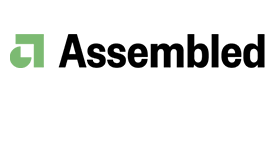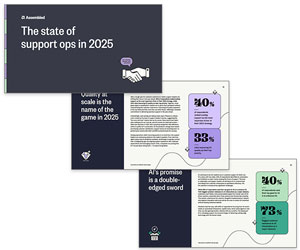We all know the challenges and stress of managing a call centre. There are schedules and forecasts to create, KPIs and budgets to meet, and customers to please.
Add advances in technology that fundamentally changed the way that many people work, shop, and live, and it can feel even more daunting. It’s a complex mixture of data and chaos, and it might feel like you’re just barely containing it.
Thankfully, there is a solution that can help you not only tackle all of these challenges but overcome them: Workforce optimization (WFO). It can help improve employee productivity and customer service, all while saving money. And I promise you, it’s real!
Ready to lower your stress level and raise your standards? This piece will define and outline the importance of workforce optimization, how to make this strategy work for your call centre, and discuss how to pick the right WFO software—ultimately boosting agent performance and operational efficiency within your call centre.
What Is Workforce Optimization?
Workforce optimization (WFO) is a collection of strategies, processes, and technologies that prioritize the improvement of customer satisfaction, operational costs, workforce scheduling, and additional KPIs in order to get the optimum performance out of your employees and the services they provide.
Essentially, WFO involves automating processes to boost productivity, maximizing smarter technology investments, and providing business data and analytics to offer detailed insights into every aspect of an organization. In call centres, WFO ultimately works to improve workforce management and agent performance.
What Is Workforce Optimization in a Call Centre?
As we mentioned above, workforce optimization is all about improving and simplifying processes in order to address challenges that businesses face. Those challenges can relate to anything from workforce management (WFM), analytics and reporting to eliminating wasted time, and more.
But in contact centres, these challenges—and the improvements and simplifications that workforce optimization offers—manifest in very specific ways. Like using integrated software features that solve common problems and elevate customer service.
For instance, technology like automatic call distribution (ACD) sends customers to the support professional that’s best equipped to handle their specific needs efficiently and completely based on data the system aggregates by analyzing a few interactions with customers.
By leveraging this technology, contact centres will be able to maximize the power of each support agent while protecting them from the undue stress from requests they may not be as equipped to handle.
Call centres can also leverage interactive voice response (IVR) technology, which is a system that provides a series of voice-responsive menus and prompts that enable customers to find and access the information they need for simple requests, without speaking to a live agent, through speech, text recognition, and digital technology.
These are just a few examples of how contact centres have leveraged technologies to streamline operations as part of an overall WFO strategy that helps to improve customer service, while maximizing the skills of their staff.
Why Is WFO Important?
Implementing a WFO strategy allows your centre to increase the efficiency of your entire operation with different tools and integrated technologies that operate as one unified platform.
An effective WFO solution can produce many benefits for your contact centre, including increasing savings, customer retention, and more.
Improved Customer Service and Retention
Have you ever had dismal service at Starbucks and took to Twitter to complain about it? You aren’t the only one.
Today’s consumer is more discerning, more demanding, and have even more ways to trumpet their displeasure after a less than positive customer service experience, thanks to social media.
Consequently, the customer service that your support professionals provide plays an even more critical role in positively representing your brand and driving success for your entire organization.
Not only will people likely share their instances of crummy customer service, but, according to a 2019 Microsoft report, an estimated 58% of customers won’t return to a business after one unsatisfactory experience.
WFO improves customer service in that it provides you with insights about past customer interactions that allow you to make a plan to resolve future queries quickly and efficiently.
By implementing new tools to assist or streamline scheduling, and finding ways to improve agent performance your centre can significantly improve customer satisfaction and retention.
Boost Efficiency and Productivity
Staffing is one of the biggest expenses that most call centres have. It can cost upwards of $4,800 to hire a new support professional, and that’s not accounting for the loss in productivity during the training and onboarding process.
And yet, your first thought might be to cut your staff numbers to meet financial benchmarks, but having too few agents is a surefire way to burn out your team and frustrate your customers—both of which take big bites out of your bottom line.
WFO helps you find that elusive balance of the right number of agents without overscheduling or overspending by maximizing employee productivity through continuous training, quality management (more on that later), and more.
WFO also helps you to manage workflow processes across various departments leveraging one platform which improves the overall performance of your contact centre and your employees.
Increase Savings
An effective workforce optimization strategy will help create a stronger and more confident team of agents.
Finding the happy medium of overstaffing and understaffing can reduce turnover and the possibility of losing money because of bad customer service.
The money your department saves can be invested in initiatives and activities that help to improve company morale, like an incentive program for retreats in Hawaii!
What Are the Components of WFO?
We’ve established that WFO is a multifaceted approach to maximizing the skill of your workforce to ensure your customers are well taken care of, but what does it entail exactly? There are several key components that all contact centres use to build the foundation of their WFO platform and here’s what you need to know about each one:
Workforce Management
Simply put, workforce management is the use of technology, strategy, and processes to optimize productivity.
Call centres use this integrated approach to accurately forecast and properly schedule agents which helps to maximize operations.
By trading those antiquated spreadsheets for robust WFM software that leverages automation, you will be able to streamline employee scheduling, easily develop more accurate forecasts, monitor SLAs and KPIs in real-time, and so much more.
The good news is that there are many WFM options available. Here are some great features you should consider when vetting them:
- Creates Accurate Forecasts – With accurate forecasts, you will have agents ready when you need them. The right forecast leads to the right schedule, keeping both your customers and agents happy.
- Powerful Scheduling Tools – A quality WFM software will leverage automation to help you develop schedules quickly, offer skills-based scheduling and enable your team members to self-schedule and swap shifts.
- Real-time Adherence Monitoring – One unhappy customer is one too many, so look for a WFM solution that has the ability to monitor your employees in real-time.
- Robust Historical Reporting – Reviewing historical data will help identify patterns, skills to sharpen, and trends in inquiries. Make sure that your technology solution offers easy access to the data you need.
Quality Management
Customer satisfaction is the ultimate goal for any contact centre. So the quality management (QM) or quality assurance (QA) team works to ensure that customer standards goals are not only being met but exceeded whenever possible.
In the context of a call centre, QM software will spot-check calls and other forms of communication to make sure that standards are being upheld.
On the analytical side of the spectrum, the software will also review historical reports to ensure that calls are being handled efficiently as well.
Here are additional features QM software should have:
- Easy-to-use Interface – Your tools should be easy to use and customize. If you have other systems in place, look for a platform that can be integrated to give you access to other applications you regularly use.
- Customizable Review Forms – No organizations, teams, or even agents are identical. You should have access to forms that can adapt to your call centre’s needs and KPIs, as well as to individual agents and their performance.
- Clear Scoring System. Your software should allow you to develop a clear and comprehensive method of reviewing calls that lets the agent know where they stand and how to continually improve. This is essential if you want to harness the powers of gamification within your team.
Customer Interaction Metrics
A recent study estimated that more than 65% of contact centres are looking to invest in software with advanced analytics.
The reasoning behind this desire for data is simple: it can help improve nearly every aspect of call centre operations, from customer interaction metrics to real-time management.
While call centres have never had a shortage of data, they’ve always struggled with interpreting all the data available to them in a useful way.
Modern analytics tools solve this issue by quickly and efficiently analyzing customer interaction data to benchmark how a centre’s performance compares to its customer service goals.
Gamification
Who says you can’t play games at work? Gamification is all about bringing the elements of competition (games, points, awards, and shared challenges) to the workplace.
It’s a great way to incentivize your team and create a positive workplace culture. When you’re in an industry that struggles with burnout and retention, gamification helps to ensure your agents have a bit of fun while improving their skills.
How to Make Workforce Optimization Work for You
We’ve broken down what WFO is. Now, let’s get into some real-world ways of how you can get the most out of WFO in your call centre today.
Customer-First Perspective
Are both your big-picture goals and your simple daily activities focused on customer satisfaction? If not, they should be. It’s important to be open to change.
The old adage “if it ain’t broke, don’t fix it” doesn’t leave room for improvement. And that is the very point of WFO. As the industry changes, you need to adjust your WFO plans to change with it and always strive to do better.
Time Management and Attendance Tracking
Knowing exactly how your team members are spending their time can help eliminate wasteful processes, and keep your agents focused on their most important tasks.
Attendance tracking can identify important patterns, which gives you the power to head-off issues before they become capital-P Problems or prevent them altogether.
Scheduling
Streamlined scheduling ensures that the most qualified people are on the shifts that need them most, but also works to ensure employees don’t feel burnt out. The right schedule is one that meets the needs of your customers and your employees.
Performance and Task Tracking
If you have the right technology, it will be easy to track schedule and task adherence and identify when employees need some refresher training.
How to Choose WFO Software
When looking to invest in a WFO platform, it’s important to find a system that fits with the way your centre does business.
Figure out what components are most important to the way you do business today and in the future. Having different vendors for tools that help you to maximize different aspects of your business including scheduling, analytics, and customer engagement can get costly.
Your WFO software should allow you access to all these areas in one unified platform, so you can spend more time optimizing your centre’s operations instead of getting overwhelmed managing multiple vendor relationships. Here are a few more tips to keep in mind:
- Ensure it has a good user interface.
- Make sure that it can scale with your business and your departments.
- Confirm that it can easily integrate with the current tools being used.
Ensure Operational Efficiency With WFO
Ultimately, modern consumers are knowledgeable, demanding, and have become harder to please. Prioritizing the implementation of a WFO strategy will help you to meet your customers’ growing (sometimes endless…jk) needs.
WFO should work to enhance customer experience by boosting productivity, increasing efficiency, and improving agent performance, all of which drive the success of your centre.
A powerful, cloud-based solution creates accurate forecasts that allow you to segment across channels and queues.
It also leverages automation to instantly build schedules at scale. It even collects real-time and historical data so you can coach agents to be their best.
Take the first step to operational efficiency.
This blog post has been re-published by kind permission of Assembled – View the Original Article
For more information about Assembled - visit the Assembled Website
Call Centre Helper is not responsible for the content of these guest blog posts. The opinions expressed in this article are those of the author, and do not necessarily reflect those of Call Centre Helper.
Author: Assembled
Published On: 22nd May 2023
Read more about - Guest Blogs, Assembled






 Assembled is a Support Operations platform that helps companies maintain exceptional customer experiences, no matter what lies ahead. Leading brands use Assembled's workforce and vendor management capabilities to make optimal staffing decisions, gain visibility into performance and productivity, and unlock new ways to serve evolving customer needs.
Assembled is a Support Operations platform that helps companies maintain exceptional customer experiences, no matter what lies ahead. Leading brands use Assembled's workforce and vendor management capabilities to make optimal staffing decisions, gain visibility into performance and productivity, and unlock new ways to serve evolving customer needs. 


































